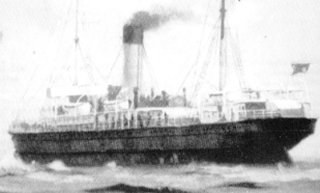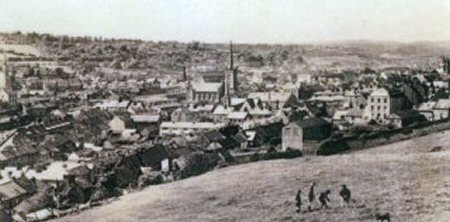‘To my son in Amerikay’.
Short Stories
Country People
O country people, you of the hill farms,
Huddled so in darkness I cannot tell
Whether the light across the glen is a star ..
Hunter
Jack McCulla walked slowly down
Window Pain
On a day when the use of plastic bullets (and/or tazer guns) by the PSNI comes once again into the news headlines, it is perhaps appropriate that we publish another one of Se
The noise of glass smashing against metal drew me to the living room window through which I could see that a riot was unfolding a few feet from our front door.
Two armoured cars were besieged by over thirty teenage boys who pelted the British army vehicles with bricks and bottles. One of the vehicles had broken down and the soldiers decided to wait inside until help arrived. The crowd grew in numbers and the ferocity of the riot increased. Suddenly there were loud bangs coming from the armoured cars and I saw puffs of white smoke emanating from little slats in both vehicles. Several rioters fell to the ground as rubber bullets pounded into their lower limbs. Two young men arrived with a ladder – a stretcher substitute – and began to ferry their wounded friends to the relative safety of the top end of the street. The D.I.Y stretcher-bearers were kept busy removing injured rioters during the ongoing battle.
Two separate groups of soldiers alighted from the vehicles, brandishing riot shields and batons. They stood still awhile, banging their batons on the riot shields before running towards the crowd. Initially the young boys fired stones at the snatch squads, but they made a hasty retreat to the opposite end of the street when they realised the soldiers meant business. However, they ran into a trap and were met by a dozen soldiers in full riot gear who arrived to provide support for their comrades. At least ten of the boys were captured and frog-marched into the next street from where they were taken in two armoured cars to a British army base. I was glued to the window. The riot had turned our street into a war zone.
My mum was in the kitchen making dinner. She was aware of the riot but she was too busy with domestic chores. She told me to stay away from the window in case the soldiers mistook me for a gunman. My mum informed me that there was a double bill of Scooby Doo cartoons starting on the television. Although I was a big fan of the canine comic, the aftermath of the riot was more appealing.
My mum began pacing up and down the living room. She lit a cigarette and mumbled something about my brother Kevin who hadn’t returned yet from a hurling match. I tried to comfort her by saying Kevin probably called to granny’s house. She also cursed out loud the absence of my father who was interned in Long Kesh. My father was heavily involved in the Civil Rights Movement but was not aligned to any Republican organisation.
A recovery lorry accompanied by two jeeps arrived, to remove the stricken military vehicle. A handful of soldiers stayed behind and began stopping and searching cars. I returned to the TV. ‘Blue Peter’ had just started. I got up to turn it over. I hated that programme for it was patronising middle-class drivel. I changed channels. ‘Top Cat’ was on ITV. I curled up on a chair to follow the exploits of ‘TC’ and ‘Benny the Ball’.
‘Oh, sweet Jesus, Holy Mary Mother of God! They have shot that wee boy,’
my mum exploded.
My mum was standing at the living room window pointing across the street to where a young boy lay beside a bicycle. The boy was motionless and there was blood pouring from his head. My mum began shouting additional religious references whilst throwing both arms in the air. She opened the front door.
A number of women were standing in the middle of the road, some of them clutching rosary beads. A soldier knelt beside the boy. He had a medical bag with him and was removing bandages from it. He was joined by local priest Fr Murphy. He knelt down beside the boy and appeared to be talking to him.
At the top of the street a soldier was being guarded by two other soldiers. Apparently he shot the boy at close range with a rubber bullet gun. The soldier had been disarmed. He cursed loudly and demanded to have his gun returned to him. Within a few minutes the soldier was whisked away in a jeep. Some of the women moved closer to the boy and began reciting prayers. Fr Murphy held the boy’s hands and blessed him. A military ambulance arrived and the priest and two soldiers wearing Red Cross armbands carried the boy into the vehicle. When the boy was on the ground it was hard to see his face and he wasn’t easily recognisable.
My mum ran to the group of women and started shouting,
‘That’s Michael McKenna! Our Kevin’s best friend’.
My mum roared and cried and some of the women sat her on a window still and tried to console her. One of the women approached me and asked me where Michael lived. I told her he lived in the next street. The woman, accompanied by Fr Murphy made their way to break the news to the McKenna family. My mum eventually returned to the house. She raised the possibility of making her way to my granny’s house, but she abandoned the idea as Fr Murphy told her the rioting had spread throughout the district.
My mum chain-smoked and paced about the house for several hours. Our front door was knocked. My mum opened the door and our Kevin entered the house with my uncle Billy. Billy was a taxi driver and one of the few members of the family with access to a car. He collected Kevin from our granny’s house when the rioting ended. Kevin, as I had expected, went to my granny’s on his way back from the hurling match. My grandparents wouldn’t let him go home alone in case he got caught up in the riot.
My mum sat Kevin down on an armchair. She was tearful, but composed herself to break the news about Michael. We had since learned that Michael had died in the hospital. When my mum told him what happened to Michael, Kevin was quiet. His face was white and his body shivered. He tried to appear defiant; tried to conceal his emotions; but he was clearly upset and angry.
My uncle left and there were just the three of us, a trinity of sadness and despair. Michael had been in our house the day before his death, joking with Kevin and my mum about a TV programme called The ‘Jimmy Young Show’. Now this twelve-year-old boy was laid in a hospital mortuary, his head blown apart by a rubber bullet that had been fired without any provocation at all. Michael was gunned down whilst riding his bike as he went to a pawnshop to collect a coat for his father, who was going to a wedding the next day.
I retired to bed, sad, confused and angry. I was ten years of age, two years younger than Michael. I just couldn’t take it in. My mum told me to say a prayer for Michael. I did, even though I didn’t understand what God could do.
I didn’t sleep much that night. I kept thinking about Michael and Kevin going to play football or hurling and chasing me away because I was too young to hang out with them. There were sporadic rioting throughout the night and gun battles raged into the dying embers of a solemn day.
The next day was Saturday and a range of kids’ TV programmes were available for us to purvey. I couldn’t bring myself to watch TV and I didn’t take any breakfast. There were bottles of lemonade and chocolate biscuits sitting on the kitchen table. These were our weekly treats. I never gave the treats a second glance. Kevin was lying on the sofa. He pretended to be asleep, but tears flowed down his face and told a different story.
My mum said the soldier who shot Michael was taken off duty. She said he would be sent back to
‘I murdered a child like you once’.
Before veil of grace descends
We, on Newry Journal, are very grateful to John Macan who has contributed many of his original poems to this site. John’s work is copyright – as indeed is all original work on this site! John has published in the past – and continues into the present – so we are especially grateful for his generosity towards Newry Journal!








